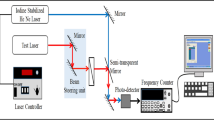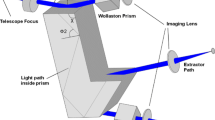Abstract
As a continuation to the published work on model based calibration technique with HESP(Hanle Echelle Spectrograph) as a case study, in this paper we present the performance results of the technique. We also describe how the open parameters were chosen in the model for optimization, the glass data accuracy and handling the discrepancies. It is observed through simulations that the discrepancies in glass data can be identified but not quantifiable. So having an accurate glass data is important which is possible to obtain from the glass manufacturers. The model’s performance in various aspects is presented using the ThAr calibration frames from HESP during its pre-shipment tests. Accuracy of model predictions and its wave length calibration comparison with conventional empirical fitting, the behaviour of open parameters in optimization, model’s ability to track instrumental drifts in the spectrum and the double fibres performance were discussed. It is observed that the optimized model is able to predict to a high accuracy the drifts in the spectrum from environmental fluctuations. It is also observed that the pattern in the spectral drifts across the 2D spectrum which vary from image to image is predictable with the optimized model. We will also discuss the possible science cases where the model can contribute.



















Similar content being viewed by others
References
Chanumolu, A., Jones, D., Thirupathi, S.: Modelling high resolution Echelle spectrographs for calibrations: Hanle Echelle spectrograph, a case study. Experimental astronomy. Astrophysical Instrumentation and Methods 39, 9457 (2015). doi:10.1007/s10686-015-9457-y
Bristow, P., Kerber, F., Rosa, M.R.: Advanced calibration techniques for astronomical spectrographs. Messenger 131, 2–6 (2008)
Redman, S.L., Gillian, N., Sansonetti, C.J.: The spectrum of thorium from 250 nm to 5500 nm: Ritz wavelengths and optimized energy levels. Astrophys. J. Suppl. Ser. 211(1), 4 (2014)
Mahadevan S., Ramsey L., Wright J., Endl M., Redman S., Bender C., Roy A., Zonak S., Troupe N., Engel L., Sigurdsson S., Wolszczan A., Zhao B.: The habitable zone planet finder: a proposed high-resolution NIR spectrograph for the Hobby Eberly Telescope to discover low-mass exoplanets around M dwarfs. Proc. SPIE 7735, Ground-based and Airborne Instrumentation for Astronomy III, 77356X (July 20, 2010); doi:10.1117/12.857551
D‟Odorico S., Avila G. and Molaro P.: “More light through the fibre: an upgrading of the link 3.6-m – CES”. The Messenger No. 58 ESO, Dec. 1989
Kaufer A., Andersen J. and Pasquini L.: “FEROS, the fiber-fed extended range optical spectrograph for the ESO 1.52-m telescope”. The messenger No. 89. Sep 1989
Raskin G., van Winckel H., Hensberge H., Jorissen A., Lehmann H., Waelkens C., Avila G., de Cuyper J-P, Degroote P., Dubosson R., Dumortier L., Fr’emat Y., Laux U., Michaud B., Morren J., Perez Padilla J., Pessemier W., Prins S., Smolders K., van Eck S., and Winkler J.: HERMES: A high-resolution fibre-fed spectrograph for the Mercator telescope. Astron. Astrophys., 526:A69, February 2011
Caffau, E., Faraggiana, R., Bonifacio, P., Ludwig, H.-G., Steffen, M.: Sulphur abundances from the SI near-infrared triplet at 1045 nm. Astron. Astrophys. 470, 699–708 (2007)
Pereira, C.B., Drake, N.A.: High-resolution spectroscopic observations of two chemically peculiar metal-poor stars: HD 10613 and BD+0402466. Astron. Astrophys. 496(3), 791–804 (2009)
Reddy, B.E., Lambert, D.L., Gonzalez, G., Yong, D.: Spectroscopic analysis of two carbon-rich post-asymptotic giant branch stars. Astrophys. J. 564, 482–494 (2002)
Bouchy, F., Pepe, F., Queloz, D.: Fundamental photon noise limit to radial velocity measurements. Astron. Astrophys. 374, 733–739 (2001)
Seifahrt, A., Kaufl, H.U., Zangl, G., Bean, J.L., Richter, M.J., Siebenmorgen, R.: Synthesising, using, and correcting for telluric features in high-resolution astronomical spectra. A near-infrared case study using CRIRES. Astron. Astrophys. 524, A11 (2001)
Huang, C., Zhao, G., Zhang, H.W., Chen, Y.Q.: Chemical abundances of 22 extrasolar planet host stars. Mon. Not. R. Astron. Soc. 363, 71–78 (2005)
Fox, A., Richter, P., Fechner, C.: VLT/UVES observations of peculiar α abundances in a sub-DLA at z~1.8 towards the quasar B1101-26. Astron. Astrophys. 572, A102 (2014)
Author information
Authors and Affiliations
Corresponding author
Additional information
The work was carried out by Anantha Chanumolu during her time at the Indian Institute of Astrophysics
Rights and permissions
About this article
Cite this article
Chanumolu, A., Thirupathi, S., Jones, D. et al. Performance results of HESP physical model. Exp Astron 43, 39–58 (2017). https://doi.org/10.1007/s10686-016-9519-9
Received:
Accepted:
Published:
Issue Date:
DOI: https://doi.org/10.1007/s10686-016-9519-9




